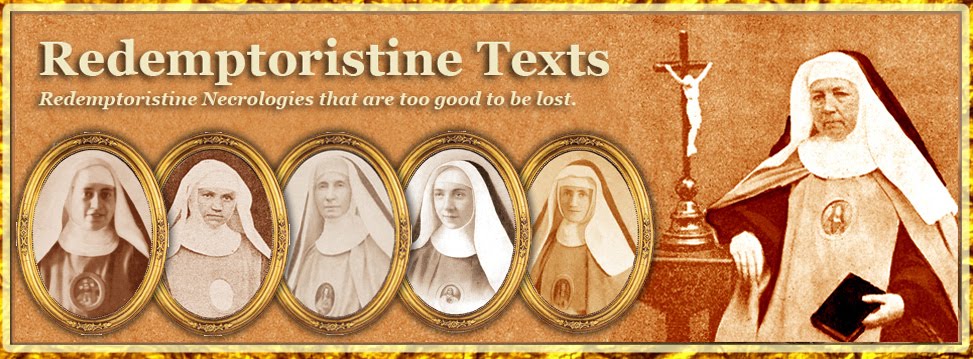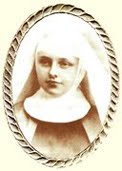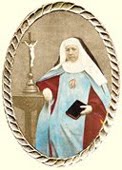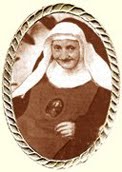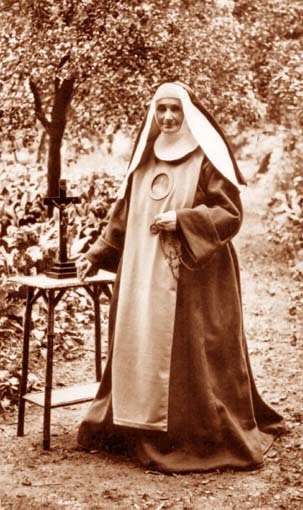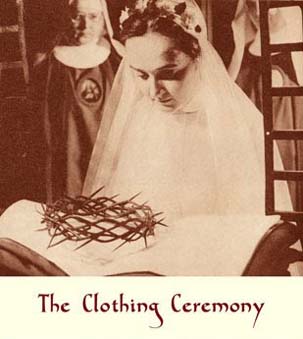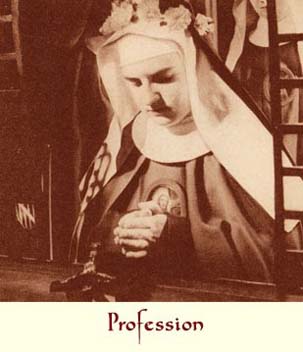Foundress of the Convent of the Redemptoristines of Velp, near Grave, founded in 1858
Chapter IV. Re-entry into the house of the Lord.
We have seen that Miss Celestine Platton had asked for her admission into the community of the Redemptoristines of Bruges in 1844. Some Redemptoristines had in fact come from Vienna in 1841, having as their Mother Superior Marie-Alphonse of the Will of God. She had received her religious habit at Saint Agatha of the Goths, the very place where Saint Alphonsus had formerly shown himself as a model bishop.
When this worthy religious learnt that the Revolution had chased all the children of Saint Alphonsus from the capital of Austria, she wished to receive into her own community all the Sisters of Rennweg Street, but the prudence of Monsignor the Bishop of Bruges permitted her to take only three of them.
As Sister Marie-Cherubine saw herself coming back to her own country following the persecution in Vienna, she believed that, in these sad circumstances, she would do well to ask to be attached to the Community of Bruges, where she already had one of her own sisters, Marie-Claire of the Holy Sacrament. So she humbly begged her Superior at Aix-la-Chapelle to permit her to withdraw into the convent of the Redemptoristines at Bruges, even if it was in the quality of a converse Sister.
This last proposition was not accepted, but it is an evident proof not only of Marie-Cherubine’s love for the cloistered life, but also of her profound humility. The community of Bruges was happy to receive her as a Choir Sister, as Marie-Cherubine would be an excellent acquisition for their house. She arrived there on 20th April, Holy Thursday in the year 1848, towards midday.
The welcome given to her was one of great warmth. She had been so severely tested, she had suffered so much, and now she was coming to find a refuge with her fellow Sisters! Scarcely had the Sister at the door set eyes upon her than she ran to the bell to announce her arrival. All the religious, clad in their blue mantles, with a candle in their hands, went solemnly to the door of the enclosure to give their welcome to Sister Marie-Cherubine. They all greeted her and embraced her cordially, and after the sincerest congratulations, they led her to the choir chanting the beautiful canticle: “Ecce quam bonum”. How beautiful it is, how agreeable it is for Sisters to dwell together in the house of the Lord and be there but one heart and one soul! (Ps. 132:1). Then the Reverend Mother Superior herself showed her the cell that had been set aside for her.
After leaving Vienna, Marie-Cherubine had not been able to wear her religious habit, because it would have attracted too much attention, but now she could put off her secular costume in order to once more put on the habit of the spiritual daughters of Saint Alphonsus. From now on she could live in community as before, follow all the regular exercises, and in a word, be a religious in all the significance of the term. What happiness, after such painful struggles, and after such cruel persecutions! A new horizon was opening before her, the sombre revolution had disappeared and heaven had become serene again. With courage and fervour she once more began her life as a true daughter of Saint Alphonsus. The events had given her an experience of things and had attached her with all her heart and all her soul to her beautiful and dear vocation. And then, after a few days of rest, she ardently applied herself to the community exercises, and all the religious who knew her have testified that she was a model of obedience, humility and loving kindness to all her fellow Sisters.
One of them, now very aged but still in this world, who saw her close up, declares “that she was the first in observance of the holy Rules and inspired by a special fervour in the recitation of the Divine Office, which she would never have omitted for no matter what reason, because she found her whole happiness in being able to be close to her heavenly Spouse.”
However, trials of a new kind would soon fall upon Sister Marie-Cherubine. This time the crosses came to her from the part of her Superiors. It was found good, the notes that were written about her tell us, to test her virtue. For this reason, it was made their task to humble and reprimand her at every chapter of faults. They even made her begin her Educandate and her Novitiate all over again, even though she had already made her profession. “But,” says the Sister whose witness we have reported above, “she accepted everything with the best grace in the world, as no sacrifice was too much, provided that she could remain in her vocation.” So with the most profound humility she once more did all the exercises of the Educandes and Novices, always placing herself as the least of all, and by her exemplary conduct she was an example to her Sisters, to the point that often, and even now, she was the object of their conversations.
This trial, we cannot doubt, was placed upon her to augment her merits and make them more agreeable to the Heart of Our Lord, who united Himself even more intimately with His creature the more she was humbled. Marie-Cherubine thus came out of the combat even greater and more truly glorious than the conqueror who is glorified by his triumph over his enemies, as the greatest victory that we can win is surely the one we win over ourselves.
These humiliations elevated Sister Marie-Cherubine in the eyes of God, and they also increased the esteem that her fellow Sisters had conceived for her. The same Sister says: “All of them esteemed and cherished her. Her Superiors held her in particular esteem, and indeed, some years later, in 1858, they imposed upon her the honourable, but also very heavy task of founding a new Monastery in Holland and being its Superior.”
When this worthy religious learnt that the Revolution had chased all the children of Saint Alphonsus from the capital of Austria, she wished to receive into her own community all the Sisters of Rennweg Street, but the prudence of Monsignor the Bishop of Bruges permitted her to take only three of them.
As Sister Marie-Cherubine saw herself coming back to her own country following the persecution in Vienna, she believed that, in these sad circumstances, she would do well to ask to be attached to the Community of Bruges, where she already had one of her own sisters, Marie-Claire of the Holy Sacrament. So she humbly begged her Superior at Aix-la-Chapelle to permit her to withdraw into the convent of the Redemptoristines at Bruges, even if it was in the quality of a converse Sister.
This last proposition was not accepted, but it is an evident proof not only of Marie-Cherubine’s love for the cloistered life, but also of her profound humility. The community of Bruges was happy to receive her as a Choir Sister, as Marie-Cherubine would be an excellent acquisition for their house. She arrived there on 20th April, Holy Thursday in the year 1848, towards midday.
The welcome given to her was one of great warmth. She had been so severely tested, she had suffered so much, and now she was coming to find a refuge with her fellow Sisters! Scarcely had the Sister at the door set eyes upon her than she ran to the bell to announce her arrival. All the religious, clad in their blue mantles, with a candle in their hands, went solemnly to the door of the enclosure to give their welcome to Sister Marie-Cherubine. They all greeted her and embraced her cordially, and after the sincerest congratulations, they led her to the choir chanting the beautiful canticle: “Ecce quam bonum”. How beautiful it is, how agreeable it is for Sisters to dwell together in the house of the Lord and be there but one heart and one soul! (Ps. 132:1). Then the Reverend Mother Superior herself showed her the cell that had been set aside for her.
After leaving Vienna, Marie-Cherubine had not been able to wear her religious habit, because it would have attracted too much attention, but now she could put off her secular costume in order to once more put on the habit of the spiritual daughters of Saint Alphonsus. From now on she could live in community as before, follow all the regular exercises, and in a word, be a religious in all the significance of the term. What happiness, after such painful struggles, and after such cruel persecutions! A new horizon was opening before her, the sombre revolution had disappeared and heaven had become serene again. With courage and fervour she once more began her life as a true daughter of Saint Alphonsus. The events had given her an experience of things and had attached her with all her heart and all her soul to her beautiful and dear vocation. And then, after a few days of rest, she ardently applied herself to the community exercises, and all the religious who knew her have testified that she was a model of obedience, humility and loving kindness to all her fellow Sisters.
One of them, now very aged but still in this world, who saw her close up, declares “that she was the first in observance of the holy Rules and inspired by a special fervour in the recitation of the Divine Office, which she would never have omitted for no matter what reason, because she found her whole happiness in being able to be close to her heavenly Spouse.”
However, trials of a new kind would soon fall upon Sister Marie-Cherubine. This time the crosses came to her from the part of her Superiors. It was found good, the notes that were written about her tell us, to test her virtue. For this reason, it was made their task to humble and reprimand her at every chapter of faults. They even made her begin her Educandate and her Novitiate all over again, even though she had already made her profession. “But,” says the Sister whose witness we have reported above, “she accepted everything with the best grace in the world, as no sacrifice was too much, provided that she could remain in her vocation.” So with the most profound humility she once more did all the exercises of the Educandes and Novices, always placing herself as the least of all, and by her exemplary conduct she was an example to her Sisters, to the point that often, and even now, she was the object of their conversations.
This trial, we cannot doubt, was placed upon her to augment her merits and make them more agreeable to the Heart of Our Lord, who united Himself even more intimately with His creature the more she was humbled. Marie-Cherubine thus came out of the combat even greater and more truly glorious than the conqueror who is glorified by his triumph over his enemies, as the greatest victory that we can win is surely the one we win over ourselves.
These humiliations elevated Sister Marie-Cherubine in the eyes of God, and they also increased the esteem that her fellow Sisters had conceived for her. The same Sister says: “All of them esteemed and cherished her. Her Superiors held her in particular esteem, and indeed, some years later, in 1858, they imposed upon her the honourable, but also very heavy task of founding a new Monastery in Holland and being its Superior.”
This necrology is translated from Fleurs de l'Institut des Rédemptoristines by Mr John R. Bradbury. The copyright of this translation is the property of the Redemptoristine Nuns of Maitland, Australia. The integral version of the translated book will be posted here as the necrologies appear.
